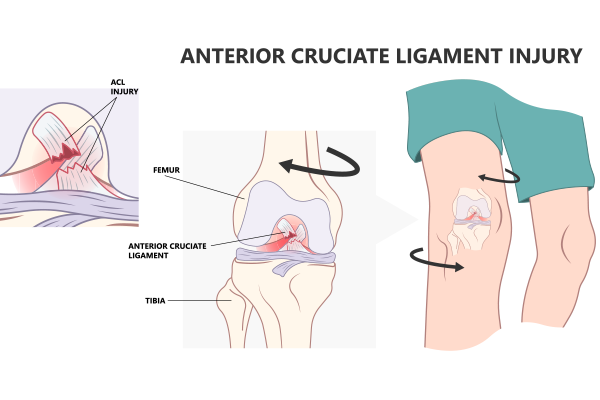
The anterior cruciate ligament (ACL) plays a critical role in knee stability by preventing excessive forward movement of the shin bone (tibia) relative to the thigh bone (femur). Unfortunately, ACL tears are among the most common knee injuries, particularly for athletes engaged in sports that involve sudden stops, pivots, or jumps.
This blog provides a comprehensive overview of ACL injuries, covering symptoms, recovery, and effective preventive measures.
Synopsis
The Ouch Moment: Signs and Symptoms of an ACL Tear
An ACL tear often occurs with a loud "pop" sound followed by sharp pain in the knee. If you experience any of the following symptoms, it’s crucial to seek immediate medical attention:
|
Symptom |
Description |
|
Instability |
The knee feels loose or wobbly, especially when standing or changing direction. |
|
Swelling |
Rapid swelling around the knee joint within a few hours of injury. |
|
Severe Pain |
Intense pain, particularly at the moment of injury, limiting movement. |
|
Loss of Motion |
Difficulty bending or straightening the knee fully. |
If you experience these symptoms after a sports injury, fall, or sudden twist, consult our orthopaedic specialists in Manipal Hospital, Gurugram for an accurate diagnosis and treatment plan.
The Road to Recovery: Stages and Expectations
Recovering from an ACL tear requires months of rehabilitation, and adherence to physical therapy is crucial. Here’s a breakdown of the recovery timeline:
|
Phase |
Duration |
Key Focus |
|
Phase 1: Initial Recovery |
0-2 weeks |
Pain management, controlling swelling and immobilization with a brace. |
|
Phase 2: Strength Training |
2-4 months |
Building quadriceps, hamstrings, and core strength. Balance exercises. |
|
Phase 3: Functional Training |
4-6 months |
Advanced strengthening, plyometrics, and agility drills. |
|
Phase 4: Return to Sport |
6-9+ months |
Gradual reintroduction to sports with therapist guidance. |
Pro Tip: Full recovery and return to unrestricted activity can take 9 months or longer, depending on the severity of the tear and rehabilitation progress.
If you’re considering ACL surgery in Gurugram, book an appointment with our orthopaedic specialists at Manipal Hospital.
Preventing the Pop: Minimizing Your Risk of an ACL Tear
While some ACL injuries are unavoidable, you can take steps to reduce your risk:

1. Neuromuscular Training
Training programs that improve muscle control, balance, and landing mechanics help prevent knee injuries.
2. Strength Training
Strong quadriceps and hamstrings provide better knee support, reducing ACL stress.
3. Maintain Flexibility
Regular stretching improves the range of motion and minimizes ligament strain.
4. Proper Warm-up and Cool-down
Warming up prepares muscles for activity while cooling down prevents stiffness and improves flexibility.
Did You Know? Studies show that athletes who incorporate neuromuscular training can reduce their risk of ACL injury by up to 50%!
Also Read: Internal Bracing: The Next Big Thing in ACL Surgery
Alternative & Holistic Approaches for Knee Health
In addition to traditional medical treatments, holistic approaches can enhance recovery and reduce injury risk:
-
Diet & Nutrition: Anti-inflammatory foods, like omega-3 fatty acids and turmeric, can support joint health.
-
Weight Management: Reducing excess body weight decreases knee stress.
-
Mind-Body Techniques: Yoga and mindfulness can improve flexibility and mental resilience.
Looking for a personalized knee care plan? Our experts at Manipal Hospital, Gurugram can guide you with customized strategies.
Conclusion: Listening to Your Knee
ACL injuries can be frustrating, but with early diagnosis, expert treatment, and diligent rehabilitation, a full recovery is achievable. Understanding the signs, recovery process, and preventive measures empowers you to take proactive steps in protecting your knee health.
If you or a loved one has experienced a knee injury, book a consultation with our orthopaedic specialists at Manipal Hospital, Gurugram today! Our team provides advanced treatments, ACL surgeries, and personalized rehabilitation plans to help you get back in the game.
Stay informed! Bookmark our blog page for the latest insights on healthcare topics, expert medical advice, and wellness tips.
FAQ's
ACL tears typically involve a loud pop, severe pain, and swelling within hours, whereas knee sprains cause mild discomfort and swelling.
Partial ACL tears can heal with physical therapy and bracing, but complete tears often require ACL reconstruction surgery for full knee stability.
Quadriceps and hamstring strengthening, balance training, and proprioception exercises are crucial for ACL recovery.
Most athletes take 6-9 months to safely return to sports, depending on rehabilitation progress and knee strength.
Yes! Performing neuromuscular training, strength exercises, and proper warm-ups can reduce ACL injury risk by up to 50%.
Pain is managed with anaesthesia during surgery and pain medication post-surgery, followed by physical therapy for recovery.
Delaying treatment can lead to chronic knee instability, increased risk of meniscus damage, and potential osteoarthritis in the long run.



















 4 Min Read
4 Min Read




.png)











